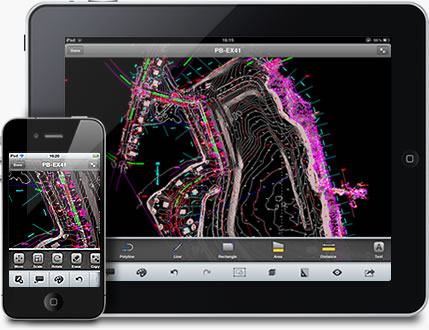|
Articles
30 Sep 2011 
Innovator's dilemma of AutoCAD WS: interview with Tal WeissAutodesk Forum in Moscow (see "Autodesk turns to PLM and demonstrates its leadership in cloud/mobile technologies") allowed Dmitry Ushakov to meet several really interesting people. Tal Weiss is definitely one of them. Former CEO and co-founder of Visual Tao (this Sequoia venture backed company developed cloud technologies that enable engineers to edit and share design data online and was acquired by Autodesk in 2009) he now takes a management position at Autodesk's Israeli R&D center.
In Moscow Tal presented AutoCAD WS and reported interesting facts on this software: 2.5 million users, 3.2 M downloads for iOS and Android, 5 M shared files. He also demonstrated collaborative work (co-editing) with AutoCAD WS. After the presentation Tal gave an interview for isicad.net.

Tal, when you founded Visual Tao four years ago, what was your main purpose?
I started my company after service in the Army. The idea come from Iris Shoor to organize company called Visual Tao, which eventually become AutoCAD WS. She was working as an architect, not a software engineer. This was back in 2006, when all kind of things were happening in the online space, the whole move from web pages to web applications. She was actually playing around the Google Docs, which at that time just come out. Now it looks kind of trivial, but then it was amazing. So she was playing around with all that tools and collaboration capabilities they offered and come to idea that it would be great to add the same kind of capabilities to AutoCAD drawings, so they can be opened with web browser, viewed by other people accessing from anywhere. With all that stuff in mind she approached myself and couple of other guys and asked us can we do this, is it possible? We answered Ė send us batch of your drawings, weíll take look at it. So she sent and weíve said Ė no this is impossible! And she asked Ė why? We answered - all documents and spreadsheets have simple data structure, while drawings youíve sent to us are huge and super complex. The thing I always like about non-technical people Ė they donít get sweat with technical answer. So she still insisted Ė can we do something? So we finally came to point that it is not impossible, itís just very hard to do. And with that idea in mind we created the company.
What was the business-model? Did you supposed to sell the company to Autodesk, or you had in mind something else?
Nobody is starting healthy business with idea to give it off to somebody else. Selling it to some big corporation is not really good answer. We were looking to sell our product to the public using SaaS - similarly to Salesforce.com. So our business-model was that people are paying for this product as a service, using their web browser to access all information they need, specifically Ė design information.
Because you did not leave the company after its acquisition by Autodesk, did you changed your vision to vision of this corporation on web and cloud technologies for design and engineering. What is this vision - can you formulate it in brief?
Yes, now we charge only for products integrated to AutoCAD as a part of AutoCAD offerings, and donít charge for services. Autodesk senses changed fundamentally in the way we now using computing, similar to that shift back in 90-s, when everybody moved from large UNIX workstations to desktop PC with Windows. Now we shift again to data stored in the clouds and mobile computing. And it is very important for us to be dominant in that area, to force that market, to help to end-user to move to mobile solutions.
Web version of AutoCAD WS is based on Adobe Flash technology, right?
What are the advantages of this approach for end users in comparison with virtualization of desktop applications except its price?
The way we look at this is so called innovator's dilemma. Something new is happening but you still have all existing stuff which you want to sell. So easy way out of this is to trying to take your existing stuff and cut out of it, stick it to other platform Ė on a web browser, on mobile phone, on iPad. But with this approach youíre always in danger to do not satisfy end-user expectations. What we decided to do Ė letís look to all these new platforms from the fresh prospective to provide users with best possible experience on those platforms.
Should mobile versions of existing products support all functions of desktop versions? Do you plan to reduce the gap in functionality between AutoCAD for Windows and AutoCAD WS?
There is nothing intentional about maintaining the gap. Itís all about prioritizing what makes the sense, which function on the mobile phone or tablet will give user most amount of value. So we shall work according to our roadmap, you canít implement all at once, no matter how large is your organization Ė there always is some limit of resources. So we have to put in the first row the most relevant features for each platform.
Do you think that some functions will be never implemented on mobile platforms? Does the gap in their prices depending on the gap in functionality?
I think that there is nothing which should stop us from business or a legal point of view. We should be sure that weĎre investing in and stuff we put in the product gets used by people. This is approach similar to the Apple for example. They really focus on the things, which are important, making product very simple and easy and crispy in use.
First tablet computers were presented in 2000, but this market started to boom only in 2010, when Apple launched its iPad. I must admit that for my personal needs (emailing, social networking, web browsing, management of my home media) iPad completely replaces my laptop. However, it is still not so appropriate for professional needs. Do you think this gap will be erased sometime? Do you see technical limitation of tablets, which does not allow them to replace desktops and laptops for professional users, especially for design and engineering?
From a hardware prospects mobile devices certainly are weaker than high-end desktop workstations in ration of 1:4 or even 1:5 because of faster processors, graphics cards, bigger amount of memory. From another hand you see the large pace of technological advance when we comparing with situation just two years ago, when there were no iPad. Now it creates full new category of devices, vendors come with new, bigger and faster versions every year or even every six months. I do think that there is the race between Google and Apple and, even Microsoft to get things to the point where tablets will can do everything desktop computers can. Couple that with cloud architecture which offloads a lot of heavy-duty computing and situation is changed, it does feel to me that in the future weíre not too distant from use mobile devices for majority of tasks we can do now on desktops.

AutoCAD WS now runs on iOS, Android and web. What version is most popular?
I would say iOS and Android are going head-to-head. Itís really differs by the geography. In North America Apple has huge advantage, while in Asian countries like Korea and Japan Android is huge, because itís supported by local vendors like Samsung. From another hand in countries like Brazil the web is stronger.
Do AutoCAD WS and AutoCAD for Windows (or Mac) have a portion of common code? How do you collaborate with AutoCAD team? Or you don't need it?
I think it would be hard to avoid such collaboration. In fact mobile applications offload a lot of its work to the cloud where AutoCAD runs. It reads and writes DWG files and does a lot of other work. Basically we not only consume AutoCAD we work close with AutoCAD team on number of different tasks to provide end-user with particular functionality and features. So there is very close collaboration between WS and AutoCAD teams.
Windows 8 will run on both x86 and ARM. What version of AutoCAD do you develop for this platform?
Iíll show my personal opinion. Unfortunately to make applications run on ARM you have to recompile them because of very different architecture. Thatís put a big barrier on porting existent applications to ARM, because by all of vendors things arenít run very smoothly, so people will have to invest a huge amount of time. If we look from a user prospective, who is going to win o specific mobile devices - banking, finances or the design? So Iím not sure about such kind of changing.
What about 3D on mobile? Will we see Inventor WS (not Inventor Publisher!) someday?
Right now Iím mostly focused on AutoCAD WS. A reason is not because I think that there is no demand for Inventor but because AutoCAD today is biggest selling product. From another hand we only just begun to create AutoCAD solutions for mobile platforms, so I hardly to expect to see four different products and get lost with their releases. We started with just 2D because there is huge number of 2D drawings created in the past. Sure, 3D support will be coming to WS.
Thank you very much for your time and your answers!
See also:
Permanent link :: http://isicad.net/articles.php?article_num=14679

|